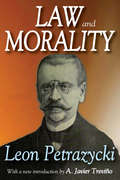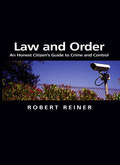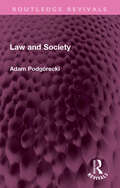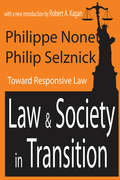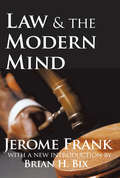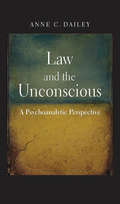- Table View
- List View
Law and Morality: Leon Petrazycki (Twentieth Century Legal Philosophy Ser. #7)
by Leon Petrazycki A. Javier TrevinoIn analyzing the socio-psychic nature and operations of intuitive legal rules, Petrazycki formulates a theory of law around five conceptual themes: anti-formalism, imperative-attributive legal relationships, law's functional control, law's subjective reality and morality. Petrazycki presents the two ways by which law coordinates and regulates social conduct as through its distributive and organizing functions. Law and Morality has a basic objective: to analyze interrelations between positive and intuitive law. Petrazycki's socio-psychic orientation toward law is behavioral as well as thoughtful. He finds the most suitable methods for obtaining knowledge about legal experiences to be internal and external observation. His technique of introspection is similar to Max Weber's conceptual method. Petrazycki distinguishes between two kinds of interpretive understanding. External observation involves deriving the meaning of an act or symbolic expression from immediate observation without reference to any broader context, and internal observation involves placing the particular act in a broader context of meaning involving facts that cannot be derived from a particular act or expression. Petrazycki's socio-legal ideas remain relevant in today's society. His arguments concerning the global expansion of human love have an attraction for those working towards a better world. In the context of positive psychology and the growing happiness industry, Petrazycki's ideas will compel legal scholars to consider his arguments. Petrazycki's work stands out for the scientific ambitions and systematic nature of his thought as well as the influence of his work on later scholars in the sociology of law.
Law and Morality
by Leon Petrazycki A. Javier TrevinoIn analyzing the socio-psychic nature and operations of intuitive legal rules, Petrazycki formulates a theory of law around five conceptual themes: anti-formalism, imperative-attributive legal relationships, law's functional control, law's subjective reality and morality. Petrazycki presents the two ways by which law coordinates and regulates social conduct as through its distributive and organizing functions. Law and Morality has a basic objective: to analyze interrelations between positive and intuitive law. Petrazycki's socio-psychic orientation toward law is behavioral as well as thoughtful. He finds the most suitable methods for obtaining knowledge about legal experiences to be internal and external observation. His technique of introspection is similar to Max Weber's conceptual method. Petrazycki distinguishes between two kinds of interpretive understanding. External observation involves deriving the meaning of an act or symbolic expression from immediate observation without reference to any broader context, and internal observation involves placing the particular act in a broader context of meaning involving facts that cannot be derived from a particular act or expression. Petrazycki's socio-legal ideas remain relevant in today's society. His arguments concerning the global expansion of human love have an attraction for those working towards a better world. In the context of positive psychology and the growing happiness industry, Petrazycki's ideas will compel legal scholars to consider his arguments. Petrazycki's work stands out for the scientific ambitions and systematic nature of his thought as well as the influence of his work on later scholars in the sociology of law.
Law and Order: An Honest Citizen's Guide to Crime and Control (Themes for the 21st Century #9)
by Robert ReinerLaw and order has become a key issue throughout the world. Crime stories saturate the mass media and politicians shrilly compete with each other in a race to be the toughest on crime. Prisons are crammed to bursting point, and police powers and resources extended repeatedly. After decades of explosive increase in crime rates, these have plummeted throughout the Western world in the 1990s. Yet fear of crime and violence, and the security industries catering for these anxieties, grow relentlessly. This book offers an up-to-date analysis of these contemporary trends by providing all honest and concerned citizens with a concise yet comprehensive survey of the sources of current problems and anxieties about crime. It shows that the dominant tough law and order approach to crime is based on fallacies about its nature, sources, and what works in terms of crime control. Instead it argues that the growth of crime has deep-seated causes, so that policing and penal policy at best can only temporarily hold a lid down on offending. The book is intended to inform public debate about these vital issues through a critical deconstruction of prevailing orthodoxy. With its focus on current policies, problems and debates this book is also an excellent introduction to criminology for the growing numbers of students of the subject at all levels.
Law and Order: An Honest Citizen's Guide to Crime and Control (Themes for the 21st Century)
by Robert ReinerLaw and order has become a key issue throughout the world. Crime stories saturate the mass media and politicians shrilly compete with each other in a race to be the toughest on crime. Prisons are crammed to bursting point, and police powers and resources extended repeatedly. After decades of explosive increase in crime rates, these have plummeted throughout the Western world in the 1990s. Yet fear of crime and violence, and the security industries catering for these anxieties, grow relentlessly. This book offers an up-to-date analysis of these contemporary trends by providing all honest and concerned citizens with a concise yet comprehensive survey of the sources of current problems and anxieties about crime. It shows that the dominant tough law and order approach to crime is based on fallacies about its nature, sources, and what works in terms of crime control. Instead it argues that the growth of crime has deep-seated causes, so that policing and penal policy at best can only temporarily hold a lid down on offending. The book is intended to inform public debate about these vital issues through a critical deconstruction of prevailing orthodoxy. With its focus on current policies, problems and debates this book is also an excellent introduction to criminology for the growing numbers of students of the subject at all levels.
Law and Social Change
by Dr Sharyn L AnleuThis is a timely new edition of Sharyn L Roach Anleu's invaluable introduction to the sociology of law and its role as a social institution and social process. Discussing current theory and key empirical research from a diverse range of perspectives Law and Social Change gives relevant examples, from various cultures and societies, to provide a sociological view which goes beyond more jurisprudential approaches to law and society. The book: • provides coverage of major classic and contemporary social theories of law • is informed by empirical research drawn from several countries/societies • includes up to date and relevant examples This thoroughly updated edition engages with modern scholarship, and recent research, on globalization whilst also looking at related issues such as the internationalization of law and human rights. It explores recent reforms at local and national levels, including issues of migration and refugees, the regulation of 'anti-social' behaviour, and specialist or problem solving courts and also provides a clear, accessible introduction to research methods used in the socio-legal field. Direct and wide-ranging this text will be essential reading for students and researchers on social science and law courses and in particular, those taking sociology, legal theory, criminology and criminal justice studies.
Law and Social Change (PDF)
by Dr Sharyn L AnleuThis is a timely new edition of Sharyn L Roach Anleu's invaluable introduction to the sociology of law and its role as a social institution and social process. Discussing current theory and key empirical research from a diverse range of perspectives Law and Social Change gives relevant examples, from various cultures and societies, to provide a sociological view which goes beyond more jurisprudential approaches to law and society. The book: * provides coverage of major classic and contemporary social theories of law * is informed by empirical research drawn from several countries/societies * includes up to date and relevant examples This thoroughly updated edition engages with modern scholarship, and recent research, on globalization whilst also looking at related issues such as the internationalization of law and human rights. It explores recent reforms at local and national levels, including issues of migration and refugees, the regulation of 'anti-social' behaviour, and specialist or problem solving courts and also provides a clear, accessible introduction to research methods used in the socio-legal field. Direct and wide-ranging this text will be essential reading for students and researchers on social science and law courses and in particular, those taking sociology, legal theory, criminology and criminal justice studies.
Law and Society: An Introduction
by Steven E. BarkanThis multidisciplinary text draws on the work of anthropologists, historians, law professors, political scientists, psychologists, and sociologists to outline how law is an essential social institution that shapes and is shaped by society. This second edition of Law and Society incorporates the latest research, with dozens of new references, along with many up-to-date examples gleaned from newsworthy events. Two new pedagogical features in each chapter will help students absorb information: learning objectives that precede each chapter’s discussion, and "Thinking about Law and Society" questions that end each chapter and encourage students to think more deeply about specific issues.
Law and Society: An Introduction
by Steven E. BarkanThe new third edition of Law and Society provides a balanced, multidisciplinary, and comprehensive overview of law as an essential social institution that both shapes and is shaped by society. Between this book’s covers, readers will find the theoretical and conceptual contributions of anthropologists, historians, law professors, political scientists, philosophers, psychologists, and sociologists. By synthesizing this wide range of perspectives, the book provides readers with a nuanced and in-depth context to think about, discuss, and analyze current trends, issues, and events. Through this book, readers will also grasp the many ways law affects the lives of individuals and, more generally, how law and society affect each other in matters such as dispute settlement, criminal law, social movements, inequality, and social control. The third edition is brought up to date with the helpful reorganization of chapters. Separate chapters exploring how we define law, the differences among the major families of law, and dispute processing make the textbook more readable and adaptable to specific course objectives. Thorough revisions across the chapters reflect the latest sociolegal perspectives and research and include many new references and contemporary examples to help students appreciate a wide range of law and society issues. This thoughtful and stimulating introduction to the field is ideal for advanced undergraduate courses in Law and Society and Introduction to Law.
Law and Society: An Introduction
by Steven E. BarkanThe new third edition of Law and Society provides a balanced, multidisciplinary, and comprehensive overview of law as an essential social institution that both shapes and is shaped by society. Between this book’s covers, readers will find the theoretical and conceptual contributions of anthropologists, historians, law professors, political scientists, philosophers, psychologists, and sociologists. By synthesizing this wide range of perspectives, the book provides readers with a nuanced and in-depth context to think about, discuss, and analyze current trends, issues, and events. Through this book, readers will also grasp the many ways law affects the lives of individuals and, more generally, how law and society affect each other in matters such as dispute settlement, criminal law, social movements, inequality, and social control. The third edition is brought up to date with the helpful reorganization of chapters. Separate chapters exploring how we define law, the differences among the major families of law, and dispute processing make the textbook more readable and adaptable to specific course objectives. Thorough revisions across the chapters reflect the latest sociolegal perspectives and research and include many new references and contemporary examples to help students appreciate a wide range of law and society issues. This thoughtful and stimulating introduction to the field is ideal for advanced undergraduate courses in Law and Society and Introduction to Law.
Law and Society: An Introduction (Mysearchlab Series 15% Off Ser.)
by Steven E. BarkanThis multidisciplinary text draws on the work of anthropologists, historians, law professors, political scientists, psychologists, and sociologists to outline how law is an essential social institution that shapes and is shaped by society. This second edition of Law and Society incorporates the latest research, with dozens of new references, along with many up-to-date examples gleaned from newsworthy events. Two new pedagogical features in each chapter will help students absorb information: learning objectives that precede each chapter’s discussion, and "Thinking about Law and Society" questions that end each chapter and encourage students to think more deeply about specific issues.
Law and Society (Routledge Revivals)
by Adam PodgóreckiOriginally published in 1974, this book looks at the general problems regarding the sociology of law. It describes the various methods of sociological research which may be applied in the field of sociology of law and shows their advantages and empirical limitations. It discusses the number and complexity of the problems connected with law, problems which are often disregarded by the traditional state and law theory. The book elucidates basic theoretical concepts including anomie, conformity, legalism, the legal norm – which are fundamental to the sociology of law. Some essential problems concerned with the politics of law are also discussed.
Law and Society (Routledge Revivals)
by Adam PodgóreckiOriginally published in 1974, this book looks at the general problems regarding the sociology of law. It describes the various methods of sociological research which may be applied in the field of sociology of law and shows their advantages and empirical limitations. It discusses the number and complexity of the problems connected with law, problems which are often disregarded by the traditional state and law theory. The book elucidates basic theoretical concepts including anomie, conformity, legalism, the legal norm – which are fundamental to the sociology of law. Some essential problems concerned with the politics of law are also discussed.
Law and Society
by Steven VagoFor one-semester undergraduate courses in Law and Society, Sociology of Law, Introduction to Law, and a variety of criminal justice courses offered in departments of Sociology, Criminal Justice, and Political Science. Examines the interplay between law and society. Law and Society, 10e provides an informative, balanced and comprehensive analysis of the interplay between law and society. This text presents an overview of the most advanced interdisciplinary and international research, theoretical advances, ongoing debates and controversies. It raises new levels of awareness on the structure and functions of law and legal systems and the principal players in the legal arena and their impact on our lives. In addition, it looks at the legal system in the context of race, class, and gender and considers multicultural and cross-cultural issues in a contemporary and interdisciplinary context.
Law and Society
by Steven VagoFor one-semester undergraduate courses in Law and Society, Sociology of Law, Introduction to Law, and a variety of criminal justice courses offered in departments of Sociology, Criminal Justice, and Political Science. Examines the interplay between law and society. Law and Society, 10e provides an informative, balanced and comprehensive analysis of the interplay between law and society. This text presents an overview of the most advanced interdisciplinary and international research, theoretical advances, ongoing debates and controversies. It raises new levels of awareness on the structure and functions of law and legal systems and the principal players in the legal arena and their impact on our lives. In addition, it looks at the legal system in the context of race, class, and gender and considers multicultural and cross-cultural issues in a contemporary and interdisciplinary context.
Law and Society
by Steven Vago Steven E. BarkanIn the 11th edition of Law and Society, Steven E. Barkan preserves Dr. Vago’s voice while making this classic text more accessible for today’s students. Each chapter now includes an outline, learning objectives, key terms, and chapter summaries. A new epilogue chapter examines law and inequality in the United States as it moves into the third decade of this century. The 11th edition reflects new developments in law and society literature as well as recent real-life events with legal relevance for the United States and other nations. Law and Society is for one-semester undergraduate courses in Law and Society, Sociology of Law, Introduction to Law, and a variety of criminal justice courses offered in departments of Sociology, Criminal Justice, and Political Science.
Law and Society: Canadian Edition
by Steven Vago Steven E. BarkanThis new edition of the landmark text Law and Society exposes readers to the dominant theoretical perspectives and sociological methods that are used to explain the interplay between law and society. This twelfth edition continues to preserve Professor Vago’s voice, while Steven E. Barkan’s use of chapter outlines and summaries, learning objectives, key terms, and additional readings maintains the text’s accessibility for today’s readers. The book’s foundational approach is brought fully up-to-date with current events and new studies throughout that illustrate how legal forces shape and influence society, and vice versa. These additions include: Updated data on trial and conviction data in federal district courts Updated data on sexual harassment of attorneys and new data on representation of women and people of color among law school faculty New discussions of legal issues arising from the Covid-19 pandemic. The twelfth edition of Law and Society is a cornerstone companion for one-semester undergraduate courses in Law and Society, Sociology of Law, and Introduction to Law offered within departments of Sociology, Criminal Justice, and Political Science.
Law and Society
by Steven Vago Steven E. BarkanThis new edition of the landmark text Law and Society exposes readers to the dominant theoretical perspectives and sociological methods that are used to explain the interplay between law and society. This twelfth edition continues to preserve Professor Vago’s voice, while Steven E. Barkan’s use of chapter outlines and summaries, learning objectives, key terms, and additional readings maintains the text’s accessibility for today’s readers. The book’s foundational approach is brought fully up-to-date with current events and new studies throughout that illustrate how legal forces shape and influence society, and vice versa. These additions include: Updated data on trial and conviction data in federal district courts Updated data on sexual harassment of attorneys and new data on representation of women and people of color among law school faculty New discussions of legal issues arising from the Covid-19 pandemic. The twelfth edition of Law and Society is a cornerstone companion for one-semester undergraduate courses in Law and Society, Sociology of Law, and Introduction to Law offered within departments of Sociology, Criminal Justice, and Political Science.
Law and Society: Canadian Edition
by Steven Vago Adie Nelson Veronica Nelson Steven E. BarkanLaw and Society provides a balanced and comprehensive analysis of the interplay between law and society using both Canadian and international examples. This clear and readable text is fi lled with interesting information, ideas and insights. All materials and supporting statistics have been carefully updated. This edition includes an expanded discussion of the law and First Nations people, recent developments impacting LGBTIQ2S persons, and persons with disabilities and a new section on civil procedures. Each chapter is structured similarly, with an outline, learning objectives, key terms, chapter summaries, critical thinking questions, and an array of additional resources.
Law and Society: Canadian Edition (Mysearchlab Series 15% Off Ser.)
by Steven Vago Adie Nelson Veronica Nelson Steven E. BarkanLaw and Society provides a balanced and comprehensive analysis of the interplay between law and society using both Canadian and international examples. This clear and readable text is fi lled with interesting information, ideas and insights. All materials and supporting statistics have been carefully updated. This edition includes an expanded discussion of the law and First Nations people, recent developments impacting LGBTIQ2S persons, and persons with disabilities and a new section on civil procedures. Each chapter is structured similarly, with an outline, learning objectives, key terms, chapter summaries, critical thinking questions, and an array of additional resources.
Law and Society in Transition: Toward Responsive Law
by Philippe Nonet Philip Selznick Robert A. KaganYear by year, law seems to penetrate ever larger realms of social, political, and economic life, generating both praise and blame. Nonet and Selznick's Law and Society in Transition explains in accessible language the primary forms of law as a social, political, and normative phenomenon. They illustrate with great clarity the fundamental difference between repressive law, riddled with raw conflict and the accommodation of special interests, and responsive law, the reasoned effort to realize an ideal of polity. To make jurisprudence relevant, legal, political, and social theory must be reintegrated. As a step in this direction, Nonet and Selznick attempt to recast jurisprudential issues in a social science perspective. They construct a valuable framework for analyzing and assessing the worth of alternative modes of legal ordering. The volume's most enduring contribution is the authors' typology-repressive, autonomous, and responsive law. This typology of law is original and especially useful because it incorporates both political and jurisprudential aspects of law and speaks directly to contemporary struggles over the proper place of law in democratic governance. In his new introduction, Robert A. Kagan recasts this classic text for the contemporary world. He sees a world of responsive law in which legal institutions-courts, regulatory agencies, alternative dispute resolution bodies, police departments-are periodically studied and redesigned to improve their ability to fulfill public expectations. Schools, business corporations, and governmental bureaucracies are more fully pervaded by legal values. Law and Society in Transition describes ways in which law changes and develops. It is an inspiring vision of a politically responsive form of governance, of special interest to those in sociology, law, philosophy, and politics.
Law and Society in Transition: Toward Responsive Law
by Philippe Nonet Philip Selznick Robert A. KaganYear by year, law seems to penetrate ever larger realms of social, political, and economic life, generating both praise and blame. Nonet and Selznick's Law and Society in Transition explains in accessible language the primary forms of law as a social, political, and normative phenomenon. They illustrate with great clarity the fundamental difference between repressive law, riddled with raw conflict and the accommodation of special interests, and responsive law, the reasoned effort to realize an ideal of polity. To make jurisprudence relevant, legal, political, and social theory must be reintegrated. As a step in this direction, Nonet and Selznick attempt to recast jurisprudential issues in a social science perspective. They construct a valuable framework for analyzing and assessing the worth of alternative modes of legal ordering. The volume's most enduring contribution is the authors' typology-repressive, autonomous, and responsive law. This typology of law is original and especially useful because it incorporates both political and jurisprudential aspects of law and speaks directly to contemporary struggles over the proper place of law in democratic governance. In his new introduction, Robert A. Kagan recasts this classic text for the contemporary world. He sees a world of responsive law in which legal institutions-courts, regulatory agencies, alternative dispute resolution bodies, police departments-are periodically studied and redesigned to improve their ability to fulfill public expectations. Schools, business corporations, and governmental bureaucracies are more fully pervaded by legal values. Law and Society in Transition describes ways in which law changes and develops. It is an inspiring vision of a politically responsive form of governance, of special interest to those in sociology, law, philosophy, and politics.
Law and the Modern Mind
by Jerome Frank Brian H. BixLaw and the Modern Mind first appeared in 1930 when, in the words of Judge Charles E. Clark, it "fell like a bomb on the legal world." In the generations since, its influence has grown-today it is accepted as a classic of general jurisprudence.The work is a bold and persuasive attack on the delusion that the law is a bastion of predictable and logical action. Jerome Frank's controversial thesis is that the decisions made by judge and jury are determined to an enormous extent by powerful, concealed, and highly idiosyncratic psychological prejudices that these decision-makers bring to the courtroom.
Law and the Modern Mind
by Jerome Frank Brian H. BixLaw and the Modern Mind first appeared in 1930 when, in the words of Judge Charles E. Clark, it "fell like a bomb on the legal world." In the generations since, its influence has grown-today it is accepted as a classic of general jurisprudence.The work is a bold and persuasive attack on the delusion that the law is a bastion of predictable and logical action. Jerome Frank's controversial thesis is that the decisions made by judge and jury are determined to an enormous extent by powerful, concealed, and highly idiosyncratic psychological prejudices that these decision-makers bring to the courtroom.
Law and the Semantic Web: Legal Ontologies, Methodologies, Legal Information Retrieval, and Applications (Lecture Notes in Computer Science #3369)
by Aldo Gangemi V. Richard Benjamins Pompeu Casanovas Joost Breukerby Roberto Cencioni At the Lisbon Summit in March 2000, European heads of state and government set a new goal for the European Union — to become the most competitive knowled- based society in the world by 2010. As part of this objective, ICT (information and communication technologies) services should become available for every citizen, and for all schools, homes and businesses. The book you have in front of you is about Semantic Web technology and law. Law is something omnipresent; all citizens — at some points in their lives — have to deal with it. In addition, law involves a large group of professionals, and is a mul- billion business world wide. Information technology is important because it that can improve citizens’ interaction with law, as well as improve legal professionals’ work environment. Legal professionals dedicate a significant amount of their time to finding, reading, analyzing and synthesizing information in order to take decisions, and prepare advice and trials, among other tasks. As part of the “Semantic-Based Knowledge and Content Systems” Strategic Objective, the European Commission is funding projects to construct technology to make the Semantic Web vision come true. 1 The articles in this book are related to two current foci of the Strategic Objective : • Knowledge acquisition and modelling, capturing knowledge from raw information and multimedia content in webs and other distributed repositories to turn poorly structured information into machi- processable knowledge.
Law and the Unconscious: A Psychoanalytic Perspective
by Anne C. DaileyHow do we bring the law into line with people’s psychological experience? How can psychoanalysis help us understand irrational actions and bad choices? Our legal system relies on the idea that people act reasonably and of their own free will, yet some still commit crimes with a high likelihood of being caught, sign obviously one-sided contracts, or violate their own moral codes—behavior many would call fundamentally irrational. Anne Dailey shows that a psychoanalytic perspective grounded in solid clinical work can bring the law into line with the reality of psychological experience. Approaching contemporary legal debates with fresh insights, this original and powerful critique sheds new light on issues of overriding social importance, including false confessions, sexual consent, threats of violence, and criminal responsibility. By challenging basic legal assumptions with a nuanced and humane perspective, Dailey shows how psychoanalysis can further our legal system’s highest ideals of individual fairness and systemic justice.
